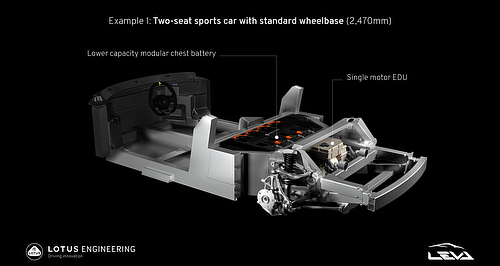Make / Model Search
News - LotusLotus unveils new lightweight EV architectureProject LEVA reveals platform for next-gen Lotus EVs and collaboration with Alpine24 Sep 2021 By MATT BROGAN LOTUS has taken the covers off its next-generation electric vehicle platform, dubbed Project LEVA (Lightweight Electric Vehicle Architecture), which will underpin the British brand’s future electric models as well as a sportscar collaboration with French rival Alpine.
Said to be up to 37 per cent lighter that the chassis of its Emira V6, Lotus says the versatile, modular platform supports multiple configurations, wheelbase lengths, battery sizes, and layouts.
It also claims to now have the ‘blueprint’ for the next generation of electric sportscars, for future Lotus products, and for the Lotus Engineering consultancy group to commercialise.
The Project LEVA lightweight chassis – formed with funding from the British government as part of a collaboration with Sarginons Industries and London’s Brunel University – will premiere at the Low Carbon Vehicle event in the UK this week alongside the Lotus Evija – the nation’s first all-electric hypercar.
“Project LEVA and the electric sports car architecture are perfect illustrations of the innovation which continues to be at the heart of everything Lotus does,” said Lotus Cars executive director of engineering Richard Moore.
“Today’s EVs are heavy in comparison to their ICE equivalents, so the ARMD (Advanced Route to Market Demonstrator) funding has helped Lotus to innovate earlier in the product cycle and develop a new vehicle architecture that targets lightweight and performance density from conception.
“Rather than developing a single vehicle, it means Lotus now has the ‘blueprint’ for the next generation of electric sports cars, for future Lotus products and for the Lotus Engineering consultancy to commercialise.”
The versatile nature of the architecture is available to view digitally through an online animation, revealing how the technology will underpin future Lotus-developed vehicles.
Lotus has already revealed several possible uses for the LEVA platform, including a two-seat model with a wheelbase greater than 2,470mm, single 350kW motor and 66.4kWh battery pack, a larger two-seater with a wheelbase greater than 2,650mm, 650kW dual- motor driveline and 99.6kWh battery pack, and a 2+2-seater also with a wheelbase greater than 2,650mm but with the availability of both single and dual motors, and the smaller of the two battery packs.
The three layouts feature a common, lightweight die-cast rear subframe with multiple interchangeable components allowing different battery configurations.
A layoud described as ‘chest’ has batteries stacked behind the rear seats while the ‘slab’ layout places the battery pack beneath the cabin floor.
LEVA’s battery cells are cylindrical, high energy density units fitted in modules using cold cure, spot bonding and advanced welding techniques that Lotus says reduce the environmental impact of assembly.
“Project LEVA is as revolutionary now as the Elise architecture was in 1996,” said Lotus head of vehicle concepts Richard Rackham.
“In true Lotus spirit, significant weight savings have been achieved throughout, with a focus on ultimate performance, efficiency and safety being engineered into the structure from the outset – for example, by utilising the vehicle structure as the battery enclosure, having an integrated EDU, eliminating bolt-on subframes and optimising the multi-link suspension components.”  Read more22nd of September 2021  Lotus details Emira V6 First Edition, due July 2022Australian pricing for 2022 Lotus Emira V6 First Edition to be confirmed next month3rd of September 2021  Lotus SUV first from new Chinese baseProduction line in Wuhan to build new Lotus models, including Type 132 electric SUV12th of July 2021  Lotus Emira a petrol swansongEmira the last ‘pure’ petrol Lotus as famed British brand moves to electrification |
Click to shareLotus articlesMotor industry news |











Facebook Twitter Instagram